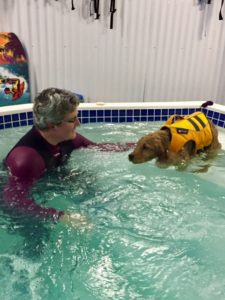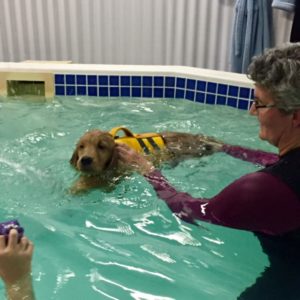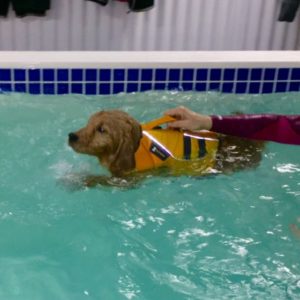It’s More Than Just a Swim Lesson
By, Gretchen Dietz
When I tell people about Splash Dog, a lot of people assume the work we do is mainly with the old and arthritic or dogs recovering from surgery. While this is definitely true, it’s also true that we provide swim lessons to perfectly fit and healthy dogs, too. “Don’t dogs naturally know how to swim?” they ask in amazement.
In the almost seven years of doing this work, I have to say I’ve never a met a dog who couldn’t swim. I’ve met quite a few who would prefer not to swim (at first), but most dogs, once introduced to the pool in a safe and patient environment, start swimming from the moment they hit the water. And most, believe it or not, learn to like it.
But swim lessons are not so much about teaching a dog to swim as they are about teaching a dog to be comfortable with swimming as a form of exercise so that if, in the future, they need therapeutic swimming, they are ahead of the game.
Sure, most young dogs don’t need therapy — they are active, healthy, and without the aches and pains of elderly dogs — but as they age, the exercises of their youth — running, jumping, leaping, fetch, etc. — take a toll on their bodies. Muscle atrophy, arthritis, limited range of motion — these are just a few of the problems that all dogs will eventually face.
Furthermore, certain breeds have genetic predispositions for future debilitating conditions like hip dysplasia in larger breeds or luxating patellas in smaller breeds. If these conditions present themselves, vets often prescribe a reduction in weight-bearing activities — like walking — and many vets encourage swimming as an alternative. In addition, some dogs who are insanely active playing fetch or catching frisbees or simply racing through their hardwood floored homes can injure their knees or their backs or pull deep muscles that require rest and limited activity. If they already know how to swim and are comfortable with it, they can recover more quickly from those injuries.
Swimming is a great exercise but it’s also great therapy. Getting your dog comfortable with it at an early age makes the therapeutic experience all the more effective.
While we can help older dogs, I always wish that dogs came to us sooner. And yes, by sooner I mean as puppies or even adolescent dogs. Why? For a number of reasons.
First, dogs who already know how to swim, who are comfortable with a warm water pool and the routine of swimming and massage, benefit more quickly from the sessions. Older dogs, especially dogs who have never see a pool let alone been in one, can take quite awhile to get comfortable with the idea of swimming. It may take three or more sessions before they really relax and often the stress of doing something they’ve never done before is exhausting for older dogs.
Secondly, dogs who swim regularly can often stave off early development of arthritis or other mobility issues. I look to my own dog as an example. At 10 years old, he’s been swimming for most of his life (and yes, a majority of that in a warm water pool). He has always had a weak ligament in his knee, but luckily we have avoided any tears or ruptures precisely, his vet and I agree, because he has been a regular, warm-water swimmer. Yes, he’s starting to show signs of arthritis, but by continuing to swim, I know that he is a lot more fit and mobile than most dogs his age.
Finally, the most important reason is the most difficult to explain to clients, but here’s my best shot. Many times we get elderly dogs in the pool who are struggling to walk, having difficulty getting up and down stairs, are stiff and sore after activity, or often have trouble standing after lying down for awhile. Their back ends slump or even collapse or they suffer more neurological issues like dragging their feet or knuckling under with their front or back feet.
When they come to the pool, I often wish the dog had started swimming a few years prior, perhaps before the symptoms really appeared. Yes, we can help with mobility of a 13 year old terrier. Yes, we can reduce the inflammation from arthritis and stiff and sore muscles of a 14 year old Border Collie . Yes, you will notice a difference — more ease getting up, more willingness to go up stairs or on longer walks, and less pain and stiffness — but if the dog had been a swimmer his/her entire life, even if the dog had started swimming at 10 years old instead of 13 years old, the benefits would be much greater and be realized much more quickly.
In other words, start now — whatever age your dog is — and get him/her comfortable with swimming in a warm water pool. Start now so that later, when your dog really needs the therapy warm water swimming can offer, she/he is already familiar with swimming as exercise. And never hesitate to start before you think your dogs needs it because eventually, she/he will and there’s nothing more beneficial for the health of your dog (no matter the age) than a warm water swim.


